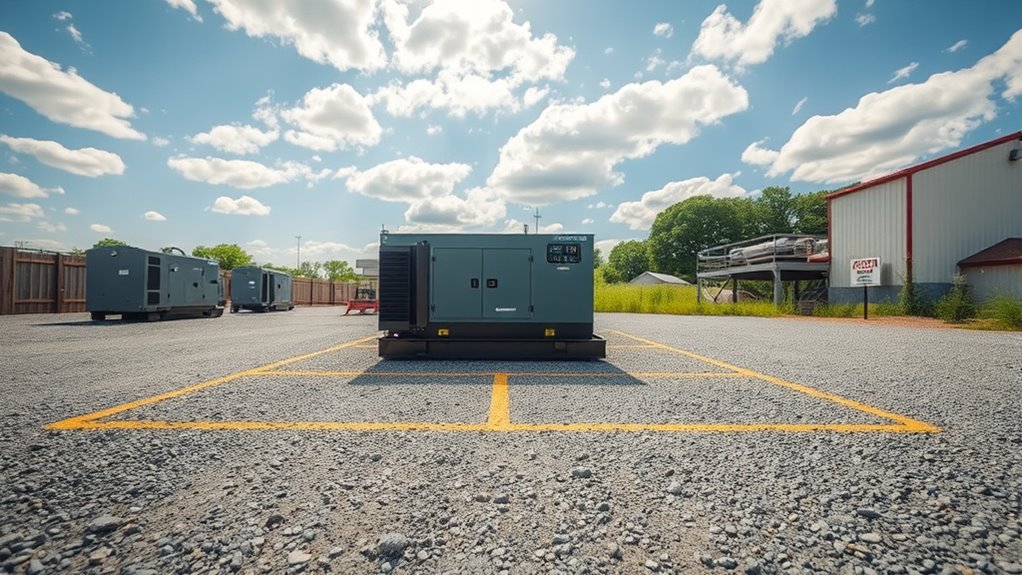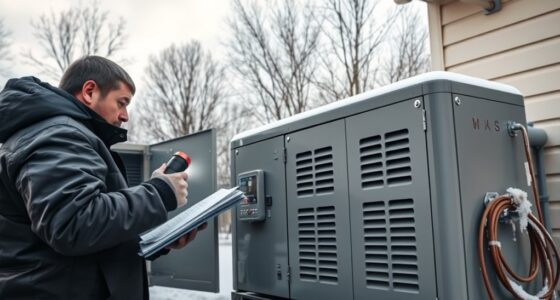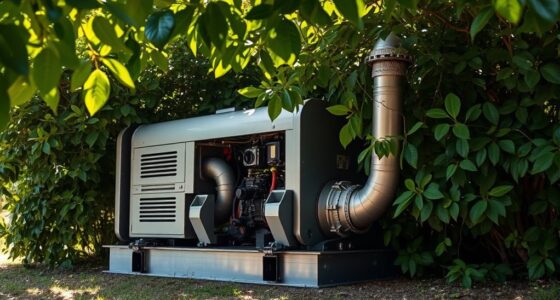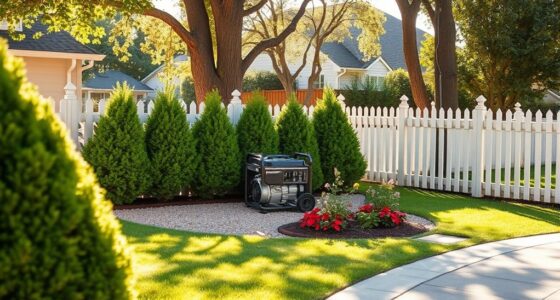To guarantee safe generator placement, keep it at least 20 feet from your home, doors, windows, and vents, with 3-4 feet of space around it for ventilation. Direct exhaust away from your house to prevent fumes from entering indoor spaces. Regularly test smoke and CO detectors, and follow manufacturer guidelines for maintenance. Proper placement, ventilation, and safety checks are key. If you want to learn more about best practices, continue exploring this essential safety guide.
Key Takeaways
- Place generators outdoors at least 20 feet from the home, doors, windows, and vents to prevent exhaust fumes from entering living spaces.
- Maintain a clear 3-4 foot radius around the generator for proper ventilation and cooling.
- Direct exhaust away from the home and open windows to prevent toxic fumes buildup inside.
- Ensure the generator is positioned on a non-combustible surface, away from sheds and combustible materials.
- Install carbon monoxide detectors near sleeping areas and outside the generator’s location for added safety.
Proper Placement and Distance Guidelines
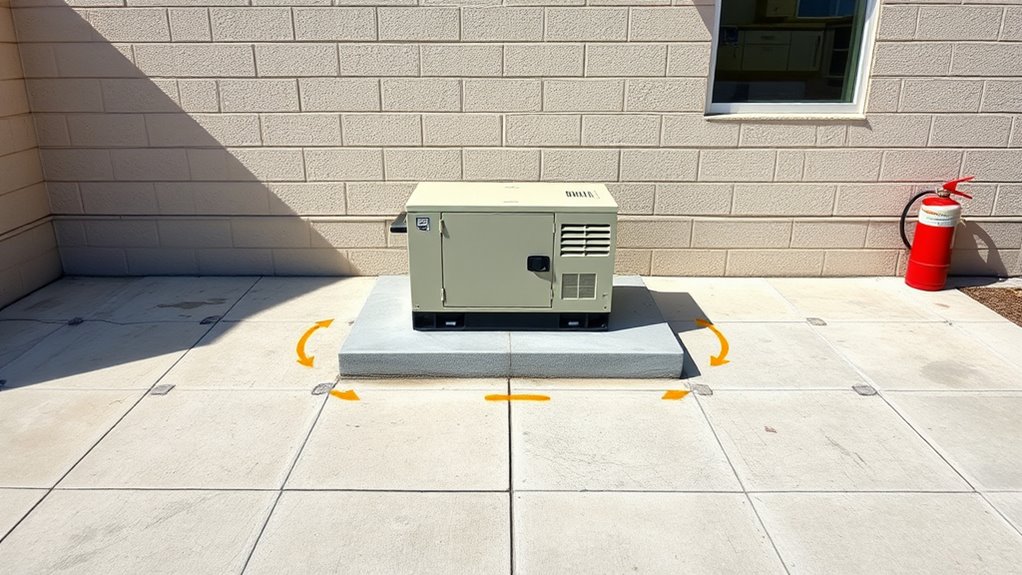
Proper placement of your generator is essential for safety and efficiency. You should position it outdoors at least 20 feet away from your home, including doors, windows, and vents, to prevent exhaust gases from entering living spaces. If 20 feet isn’t possible, maintain a minimum of 10 feet, but 20 feet remains preferable. Leave 3 to 4 feet of clear space around the generator on all sides to ensure proper ventilation and prevent overheating. Always direct the exhaust away from your home and any openings to reduce the risk of toxic fumes. Avoid placing the generator on combustible surfaces like decks or near sheds. Proper spacing minimizes fire hazards and ensures exhaust disperses safely, protecting everyone inside your home. Additionally, understanding automation in business can help you optimize your setup for safety and efficiency.
Carbon Monoxide Prevention Measures

To prevent carbon monoxide poisoning, it’s essential to install and maintain carbon monoxide (CO) detectors near every sleeping area inside your home. Check these detectors regularly to guarantee they work properly and replace batteries promptly. Consider using smart CO alarms for remote monitoring and alerts. Remember, CO gas is odorless, colorless, and undetectable by human senses, making alarms vital. Using battery-operated detectors ensures continuous safety, respond immediately if a CO alarm sounds—get to fresh air and seek medical attention if you experience symptoms like headache, dizziness, nausea, or confusion. Always use portable generators outdoors, at least 20 feet from your home, with exhaust directed away from living spaces. Ensure proper ventilation, keep the area clear, and never operate generators in wet conditions to prevent dangerous CO buildup. Regular maintenance of heating systems and appliances also reduces the risk of CO leaks and enhances overall safety.
Safe Operation and Maintenance Practices
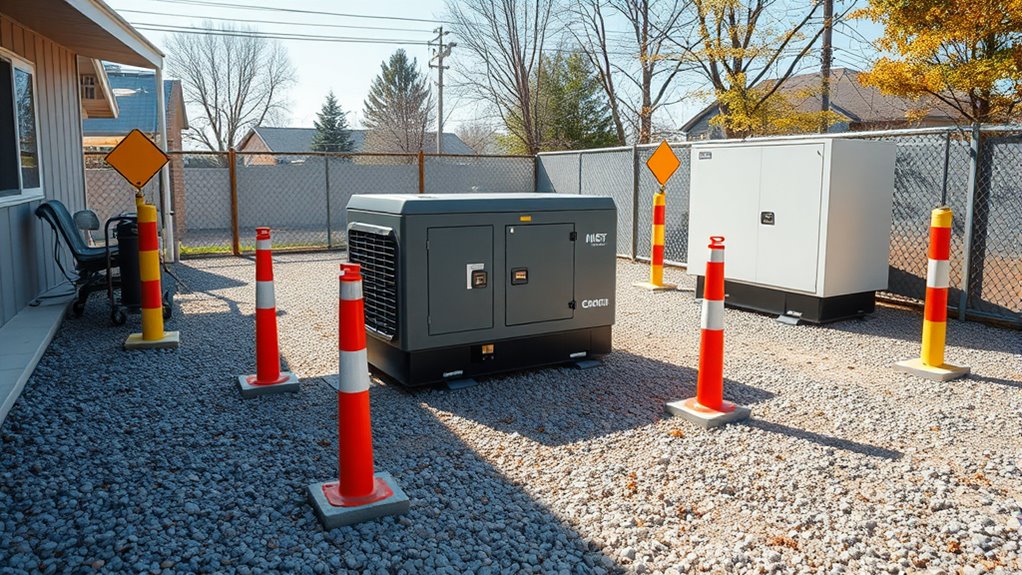
Following manufacturer instructions is crucial for safe generator operation and maintenance, ensuring each task is performed correctly and reliably. You should conduct regular inspections to identify and replace damaged parts promptly, preventing malfunctions. Always perform maintenance only when the generator is turned off and cooled down to avoid injuries and damage. Use maintenance logs to record all activities, issues, and parts replaced for future reference. Enforce scheduled maintenance cycles—annual, semi-annual, or quarterly—based on manufacturer or NFPA 110 standards. Before working on the generator, disconnect all power supplies and ensure proper electrical insulation and grounding. Store fuel safely in approved containers away from heat sources, and keep the area clean and free of combustible materials. Proper fueling, ventilation, and PPE usage are essential for safe operation and maintenance. Implementing efficient general ledger coding practices can also help track maintenance activities and improve overall operational efficiency.
Frequently Asked Questions
How Do I Determine the Best Orientation for My Generator?
You determine the best orientation by positioning your generator outdoors, at least 20 feet from your home, with the exhaust outlet pointing away from living spaces. Make certain there’s 3-4 feet of clearance around it for ventilation and cooling. Place it on a dry, stable surface, preferably under a shelter that protects from rain while allowing airflow. Always prioritize proper ventilation and keep the exhaust directed away from doors, windows, and vents for safety.
What Are the Signs of Carbon Monoxide Poisoning to Watch For?
Like a silent predator, carbon monoxide sneaks in unnoticed. Watch for early signs like headaches, dizziness, confusion, and nausea. You might feel irritable or weak, and your skin could turn pale or blue. Respiratory issues such as shortness of breath and rapid heartbeat are warning signs. If you or loved ones show these symptoms, especially after running a generator, get fresh air immediately and seek medical help to prevent tragedy.
Can I Operate a Generator During Rain or Wet Conditions Safely?
You shouldn’t operate a generator during rain or wet conditions because it increases the risk of electric shock, short circuits, and fuel explosions. To stay safe, keep the generator dry by using a cover, place it on a dry, elevated surface, and operate it outdoors in a well-ventilated area away from water. Always turn it off before refueling and avoid touching it with wet hands to prevent electrocution.
How Often Should I Inspect and Maintain Generator Cords and Plugs?
You should inspect and maintain your generator cords and plugs at least monthly, visually checking for frays, cracks, or scorching that can cause hazards. Increase the frequency in harsh environments like coastal or dusty areas. During each inspection, tighten loose connections, clean terminals, and replace damaged cords. Follow a bi-annual professional inspection, and perform additional tests if you notice unusual electrical loads or prolonged inactivity to guarantee safety and reliable performance.
What Are the Specific Requirements for Installing Transfer Switches?
You need to guarantee transfer switches are properly installed by following specific requirements. Mount them near your main electrical panel with at least 3.5 feet clearance in front for easy access. Use approved, marked transfer switches for emergency use, and install them in dry, protected locations away from moisture. Connect circuits individually, and verify wiring is correct, safe, and compliant with local codes. Finally, test the switch thoroughly after installation to confirm proper operation.
Conclusion
By following these safety guidelines, you protect your home and loved ones from unseen dangers. Imagine your generator as a silent guardian, standing too close could turn it into a hidden threat, like smoke creeping through cracked windows. Proper placement and maintenance transform it into a reliable partner, not a hazard. Stay vigilant, keep safe distances, and guarantee your generator’s power works for you—safely and securely, like a lighthouse guiding you through the storm.

